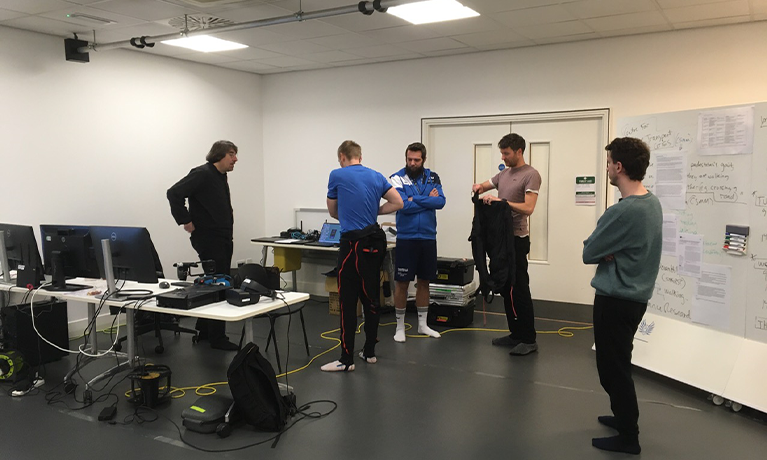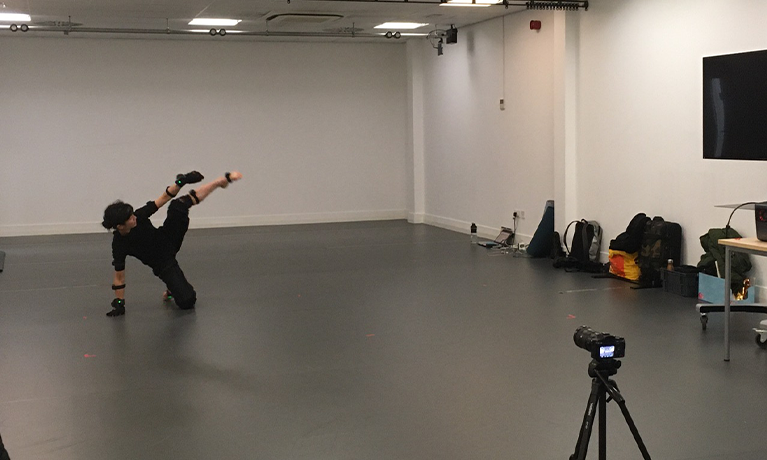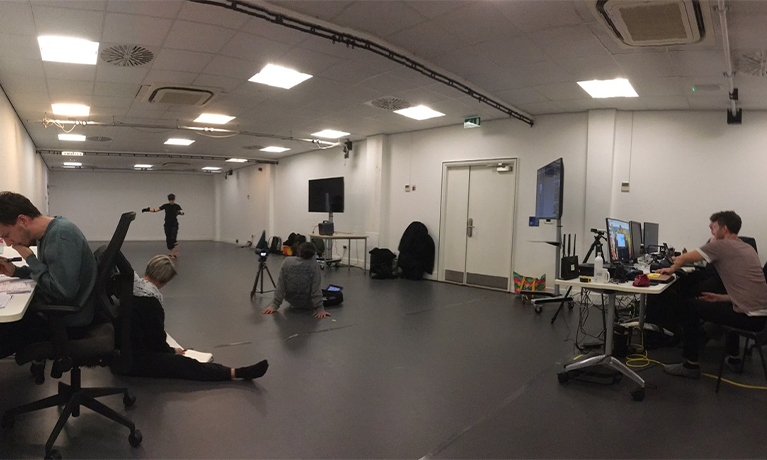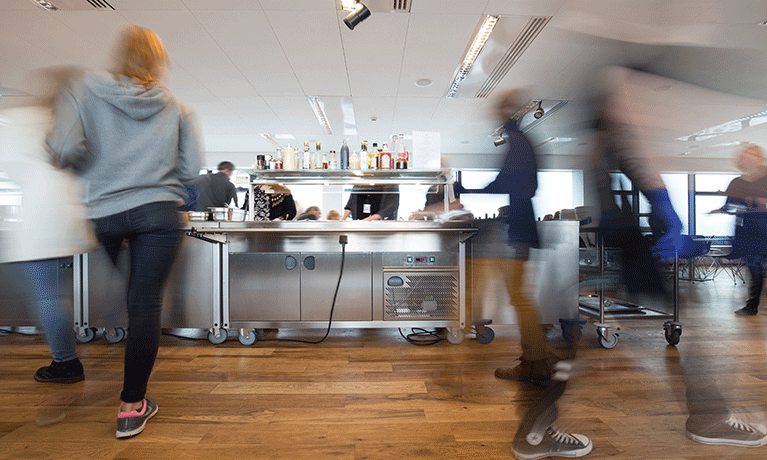Centre for Dance Research, Centre for Future Transport and Cities, Centre for Computational Science and Mathematical Modelling, Centre for Physical Activity, Sport and Exercise Sciences
Cross-Centre Motion Capture Lab. Dates: 27-30 November 2023. Location: Performance Studio. Institute for Creative Cultures (ICC) Building, Parkside, Coventry CV1 2NE. Co-organisers and facilitators: Daniel Bisig, Scott deLahunta, Ruth Gibson, Alex Masters.
The Cross-Centre Motion Capture Lab was established to explore connections between a spectrum of art-science-engineering research focussed on movement and gesture. Over the course of four days, a handful of research teams from across various research centres experimented with the motion capture systems housed at the ICC Building. The Lab facilitated the exchange and discussion of various research aims and methodologies across disciplines, fostering bridges for possible future collaboration. Participating research centres included Dance Research (C-DaRE), Future Transport and Cities (FTC), Computational Science and Mathematical Modelling (CSMM), and Physical Activity, Sport and Exercise Sciences (PASES). In addition, two guest artistic teams took part AΦE and Gibson/Martelli.
In late 2022, the Centres for Dance Research, Postdigital Cultures and Arts, Memory and Communities received UKRI funding to invest in digital technology, including motion capture. The Centres have now acquired two camera-based Kinect Azure systems and eight IMU motion capture suits including three Rokoko, two Perception Neuron, two Tesla and an Xsens Movella borrowed from FTC.[1] What makes motion capture technology unique is that it is used in both artistic and scientific movement research. This requires a significant level of technical knowledge of how to configure, calibrate and operate the systems, and the Centres have a few researchers[2] who utilise motion capture in their work, with some employing it quite extensively.

PASES researchers preparing to test an IMU suit. Photo: S. deLahunta
The Lab was envisioned as an opportunity for collaboration with Coventry researchers from diverse fields who are using motion capture technology in their work. The invitation said “the purpose is to bring together researchers from different centres/ disciplines who use motion capture in their research. We would like to spend a few days together conducting various recording and analysis sessions as designed and conducted by the separate fields involved. The goal is to enable exchange and discussion of different research approaches and methodologies with the aim of making bridges for possible future cross-centre collaboration.” Within a short time, researchers from the above centres (FTC, CSMM, PASES) had agreed to attend.
The Lab was scheduled to take place from 26-30 November 2023 and comprised eight half-day motion capture sessions with each session dedicated to a participating research team or individual researcher. Time was allocated at the beginning of each session to introduce their research interest followed by conducting motion capture recordings and a final discussion to reflect and identify possible follow-ups. A core group comprising the Lab organisers and facilitators (Daniel Bisig, Scott deLahunta, Ruth Gibson, Alex Masters) were present throughout, providing bridges between sessions, documenting and drafting a final report.

AΦE capture session. Photo: S. deLahunta.
Having many different motion capture systems gathered in one location and time is highly uncommon, and most of the participating teams were eager to test and evaluate these different systems for possible integration into their research. Many teams either had no access to these systems previously, or lacked the technical expertise required to use them effectively. The Lab was structured to foster informality, with an open-door policy encouraging drop-in observation, although this aspect was not widely advertised. A Microsoft Teams platform was set up where descriptions, team members and schedule were posted. Folders were created for easy access to reference papers, presentations, documentation, and motion capture data. The final report, encompassing the full list of participants, topics, follow-up plans, documentation and a comparative analysis of the performance of various Motion Capture systems, is available here.
Within this Lab setting, the Motion Capture technology served as a valuable meeting point. Postgraduate Researchers (PGRs) and research staff from across the four participating research centres, alongside external guests from the creative arts industries, engaged in collaborative exploration. Various discoveries were made, for example, new technical solutions for recording people walking downhill or downstairs. How using skilled performers could contribute to improved data for training machine learning models. One computing science researcher discovered early research related to their study coming from the dance and technology field. There are follow-up plans that might involve using the IMU motion capture systems again, with support from the three Centres and discussions about future research collaboration.

FTC researchers and core team wrap-up discussions. Photo: R. Gibson.
Thus, the Cross-Centre Motion Capture Lab functioned as a seedbed for ideas on an individual level with researchers taking away insights they might apply within their own discipline, as well as a starting point for possible future transdisciplinary research. The use of seeding as a metaphor deliberately points toward the idea of bottom up versus top down. What happens when researchers from different fields can share time together in a common space, without the express goal that they must develop a project together to respond to a specific call? Those are the bottom-up conditions this Lab was designed to facilitate. However, the new cross-centre connections made here will grow into something that goes beyond interdisciplinarity only if there is further collaborative investment of time and energy.
This brings us to two questions: firstly, how valuable are initiatives centred around spending time together to share research interests? And secondly, what does it take to nurture and support the new relationships that are sparked through such interactions? To answer the first question, the evidence from this Lab suggests that if a unique meeting point like motion capture technology (used in both artistic and scientific movement research)can be found and sharing time together can be facilitated then the answer is yes, it is valuable. To answer the second, we will have to wait to see where the follow up efforts go. But in the meantime, it might be worth exploring other possible unique “meeting points” within the Coventry University research community and how we can leverage them to initiate new collaborations.
Plans are underway for a follow-up Interdisciplinary Teaching & Research Motion Capture Lab in Autumn 2024 with a focus on gaming, design, and the creative industries. This lab will involve a collaboration between the Centre for Dance Research and Centre for Post-Digital Cultures as well as the Creative Technologies Cluster, College of the Arts and Society with an emphasis on building links across teaching and research. Please contact Ruth Gibson or Boyd Branch at C-DaRE for more information.
[1] IMU means inertial measurement units that measure anatomical joint angles, orientation angles, and linear acceleration in both natural and lab-based environments.
[2] Ruth Gibson and Daniel Bisig (C-DaRE) Alex Masters (CPC) all involved in organising and supporting the Lab.




Comments are disabled